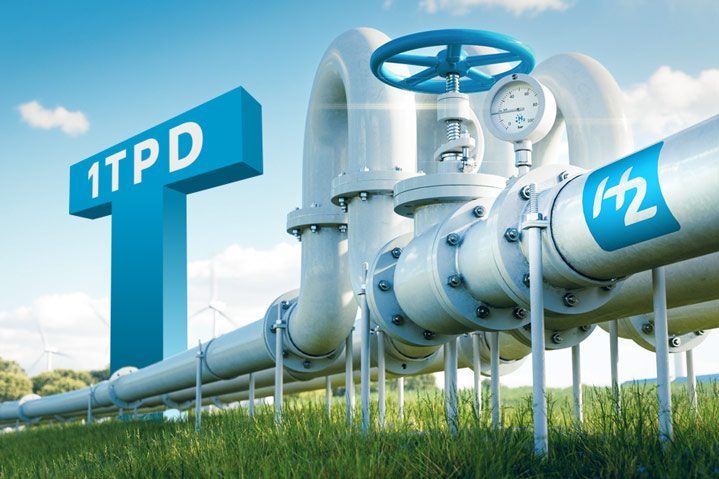Hydrogen From A to Z: T for 1TPD
By: GenH2 Staff
Read Time: 3 minutes
Defining the Hydrogen Economy from A to Z: T is for 1TPD
Continuing on in our defining the Hydrogen economy from A to Z series, we are revisiting the letter T, and discussing the word Tonne, and specifically the 1 Tonne Per Day (1TPD) system and how it relates to GenH2’s mission for supplying 1TPD systems for the Hydrogen economy supply chain.
Ton and tonne are both derived from a Germanic word in general use in the North Sea area since the Middle Ages to designate a large cask, or tun, compared to other possible origins of the old English word tunne, Latin word, tunna, and the German and French word, tonne.
Ton and Tonne have similar word origins and are both a unit of weight, however, they are not equal and not interchangeable with each other. A Ton is an Imperial measurement (still widely used in the US), and a tonne is a Metric measurement. The ton is derived from the tun, the term applied to a cask of the largest capacity. This could contain a volume between 210 and 256 US gal or 800 and 970 liters, which could weigh around 2,000 pounds (910 kg) and occupy some 60 cubic feet (1.7 m3) of space. A tonne, also known as a metric Ton, is equal to 1000 kg, (or 2,204.6 pounds) and that is the unit of measure we are focusing on today.
One tonne of hydrogen, or 1,000 kg of hydrogen, is equivalent to 14.1 m3 (3,731 gallons) of liquid hydrogen at the Normal Boiling Point (NBP) or 11,935 m3 (421,480 ft3) of gaseous hydrogen at Standard Temperature and Pressure (STP) conditions. The density of liquid hydrogen is approximately 70.8 kg/m3 at NBP and the expansion ratio from liquid-to-gas is about 850. That is, one liter of liquid hydrogen can make almost one cubic meter (850 liters) of gas at ambient conditions.
Now that we are refreshed on difference between Ton and Tonne, we move on to how that is associated with the Hydrogen supply and value chain. According to a Department of Energy (DOE)
2022 report, today’s hydrogen market is approximately 10 million metric tonnes per year (MMT/yr.) in the U.S. and 65-100 MMT/yr. globally. However, almost none of that hydrogen is electrolytic and that market is expected to grow substantially to at least 100 MMT/yr. by 2050 to meet future clean energy demands and help decarbonize globally. When it comes to discussing hydrogen’s energy value, kilograms (kg) and again tonnes are units most often used. The energy value of kilograms is about 33.3 kWh. So, a tonne of hydrogen delivers about 33 MWh and a million tonnes about 33 terawatt hours (TWh). To understand further, in electrical terms, the energy density of hydrogen can provide approximately 33.6 kWh of usable energy per kg, versus diesel which only holds about 12–14 kWh per kg. The 1 kg of hydrogen used in a fuel cell to power an electric motor contains approximately the same energy as a gallon of diesel.
To utilize that great usable energy of hydrogen, the hydrogen economy infrastructure needs to be built out to fulfill goals of the Bipartisan Infrastructure Law’s $9.5 Billion Clean Hydrogen Initiatives. GenH2 is leading out with goals of mass producing 1 tonne per day (1TPD) liquid hydrogen systems, Hydrogen Liquid Multiplexer (HLM)™ which is a 1000kg per day capacity hydrogen liquefaction unit with controlled storage capability for the next generation of liquid hydrogen-based solutions. These 1TPD systems allow for modular design architecture and could serve singularly or multi-unit system to meet end-user hydrogen consumption tonne requirements and servicing needs. Innovative approaches and solutions are being utilized to bring these 1TPD systems to the marketplace that could be game-changing for the availability of hydrogen, and specifically liquid hydrogen supply chain.
Follow us again next week as we explore another letter in our Discover the Hydrogen Economy from A to Z series.



